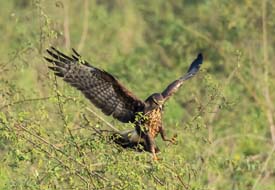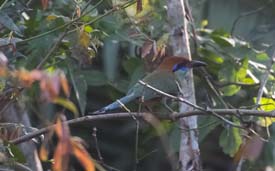The road through the plantation was a fairly rough cobblestone type that seemed very old, and very necessary if it has been raining. We worked our way down the road, stopping and scanning as best we could through the heavy foliage. We picked up lilac crowned parrot, and saw gray-crowned woodpecker; greenish elaenia; boat-billed flycatcher; ivory-billed woodcreeper; western long-tailed hermit; and red-crowned ant-tanager. Like most days of our trip we heard collared forest-falcon, but never once did we see one. Other heard only birds that morning included russet-crowned motmot, and colima and ferruginous pygmy owls.
After our siesta we visited crocodilo road which gave us a wide variety of bird life beginning with our first bare-throated tiger-heron of the trip.
We also had a northern jacana.
Groove-billed anis were around.
The first laughing falcon of our trip made an appearance, as did a black hawk.
Driving into San Blas yesterday Dave had seen a crane hawk fly over that the rest of us missed, so we were very glad when one come by.
Other birds seen along the road included white-throated, willow and vermilion flycatchers; white-collared seedeater; lincoln sparrow; thick-billed and tropical kingbirds; orange-crowned, nashville, Macgillivray's, Wilson's and yellow warblers; and mangrove and northern rough-winged swallows. After a long and pretty toasty afternoon, we were more than ready to get back to the hotel for beers and dinner.
We were up even earlier on Thursday because we had to drive over an hour to a mid elevation site for our morning birding. The area is called Cerro de San Juan. Our main targets were various hummingbirds. There were of course several white-eared, but we also picked up berylline.
The others included calliope, cinnamon and finally a bumblebee. The best though was the Mexican woodnymph.
Two birds that had been eluding us were the rufous-crowned ground-sparrow, and the rusty sparrow.
We stopped at a high altitude ranch that had a large group of spotted wrens, and along the road we found our first stripe-headed sparrow of the trip.
There were a large number of black-bellied whistling ducks, but most amazing was the huge number of female and immature snail kites.
There were also many limpkins.
As the sun fell low in the sky, we made our way back to the hotel for more beer and good food which this time of year meant lots of variations on wild caught shrimp from the Pacific ocean (photo taken by Laura Keene).
Friday morning was not quite such an early start, but we were still on the road before 6 AM. Our morning was spent walking along Singayta Road. Since we were now on our 7th full day of birding, and 3rd in the San Blas area, the number of new species for us was beginning to decline. The morning was very delightful nevertheless. Some previously seen birds included golden-cheeked and gila woodpeckers; great kiskadee; red-billed pigeon; white-winged, white-tipped, and inca doves; groove-billed ani; cinnamon hummer; orange-fronted parakeet; and dusky, pacific-slope, and social flycatchers.
New seen birds for the trip included a great black-hawk, fan-tailed warbler, Mexican parrotlet, and russet-crowned motmot.
The main reason for the boat trip was to go up river through the mangroves to the large spring that feeds the river. It was a beautiful evening, and with all the bird life it turned into a very magical time.
The number one goal was to find one of the strangest of birds--the boat-billed heron. We located 2 roost areas. A truly stunning bird, but such an odd bill.
Near dusk we found a white-tailed kite. Just before that we had an unusual encounter with a merlin that circled over our boat time and again before finally disappearing. We almost felt like the bird was dive bombing us.
The other most interesting bird of the evening was the northern potoo. Over an hour's time we encountered 8 of them. It seems like the perch goes right into its stomach since you can not see its feet. We also flushed a few paraques.
We ate later than normal, but no one was complaining after such a perfect tour of the river.






























No comments:
Post a Comment